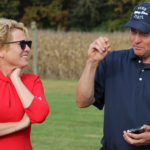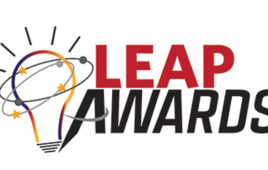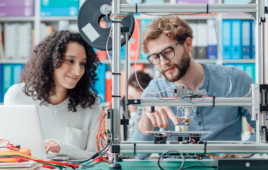From young kids to engineering students and those already in manufacturing, hands-on opportunities are essential to demonstrating the attraction to a career in engineering.
Ask most people in the workforce and they’ll agree — hands-on learning at a young age is what often drew them to a career and often, how they learned to excel at their careers. This is why introducing young people — young girls and women in particular — to STEM-related careers is critical as we begin to see greater needs for engineers and data scientists to build and maintain the machines of the future.
More companies are looking to engage students, from elementary school all the way through college in these hands-on opportunities, with everything from simple shadow days, STEM programs like the NFPA Fluid Power Action Challenge, apprenticeships and co-op internships through colleges.
Getting young kids in the fold

Dori Roberts created Engineering for Kids’ to teach engineering concepts with real-world applications all while making it fun.
In the past few years, programs to make engineering, science and math fun have exploded. In addition to the popular FIRST Lego League, the elementary school version of FIRST Robotics, others are opening children’s eyes to the joy of engineering. Just a few we know of include Eager Engineers, the NFPA Fluid Power Action Challenge, Engineering for Kids, CODE.org, Bricks 4 Kidz, and more. And specific to girls are programs like Girls Who Code, Girlstart and others.
Dori Roberts is not an engineer but a teacher who understood the importance of attracting young people to STEM careers. She is certified to teach engineering. Her undergraduate degree is in math and science elementary/middle school education and she also has a master’s degree in Technology Education grades 6 through 12. Roberts taught engineering at the high school level for 11 years. In 2009, she founded Engineering for Kids, which brings science, technology, engineering and math (STEM) to kids ages four through 14 in a fun and challenging way.
Roberts noted that a recent study conducted by Intel Corp. revealed that 63% of teens have never considered a field in engineering. Additionally, 44% said they would consider engineering as a career if they knew more about it. Engineering for Kids’ programs are designed to teach engineering concepts with real-world applications.
 “The types of fields that women are traditionally drawn to tend to be more focused on human interest; they pull at the heartstrings,” Roberts said. “Our programs are designed to teach engineering concepts with real-world applications, and the social aspect of engineering is very appealing to women — the fact that engineers improve lives and can save lives.
“The types of fields that women are traditionally drawn to tend to be more focused on human interest; they pull at the heartstrings,” Roberts said. “Our programs are designed to teach engineering concepts with real-world applications, and the social aspect of engineering is very appealing to women — the fact that engineers improve lives and can save lives.
“As the CEO of Engineering For Kids, I have the awesome job of developing exciting and engaging hands-on curriculum to teach kids engineering concepts through real world challenges,” Roberts said. “I believe that getting kids, especially girls, excited about engineering at a young age can be game changing in introducing engineering careers to women. At Engineering For Kids, we start kids as young as age four in our engineering programs. It is amazing to see the engineering designs that kids so young come up with.”
The National Fluid Power Association is attracting more attention to a future career in fluid power engineering careers with a number of programs attracted at middle school and high school and college students. Its Fluid Power Action Challenges are spreading across the country, with more girls on teams each year.
“NFPA’s Fluid Power Action Challenge events for middle school students have grown from five events to over 20 events within the last five years. Throughout the years, there have been 106 competitions taking place around the United States and impacting 10,306 students. NFPA members support these events by hosting, judging and mentoring these students and their teachers,” said Lynn Beyer, Vice President of Workforce Development Programs at the NFPA. “What is great to see is that every year more and more girls are participating, and winning!”
Keeping college students engaged
Several efforts are underway to ensure that young women do not lose interest in STEM study and careers once they reach post-secondary schools. Notably, the NFPA provides $2,000 scholarships to students pursuing fields of study related to fluid power technology. In 2018, only two of the 13 winners were young women. But in 2019, four of the 12 were young women.

Emma Brennan, left, and Amy Dolan, right, spent two weeks deeply immersed in an externship program at Park Place
Technologies, where they realized they had many practical business and technology options to use their degrees upon graduation later this year.
One unique organization is specific to Ireland but students involved in it have had a chance to visit the U.S. to learn about opportunities in STEM here. iWish (Inspiring Women in STEM) is an initiative to inspire, encourage and motivate young female students to pursue careers in Science, Technology, Engineering and Math. It was founded in Cork in 2015 and has already impacted nearly 20,000 students.
When Park Place Technologies, a third-party data center maintenance provider headquartered in Cleveland, decided to open a location in Ireland, it decided to work with some non-profits, including iWish and CoderDojo, said Jennifer Deutsch, Chief Marketing Officer. The company partnered with iWish to offer two applicants an all-expenses-paid trip to the company’s offices in Cleveland and Marlborough to gain valuable into the business of information technology and computational engineering.
Amy Dolan from University College Cork and Emma Brennan from Cork Institute of Technology — both 2021 graduates — traveled to participate in 1:1 mentorship activities, leadership training, hands-on technical experience at the company’s engineering facilities, and a concluding Capstone Project presented to the company’s executive leadership. The immersive 10-day externship really showed the two women what kinds of opportunities they can enjoy upon graduation.
Brennan became interested in computer science after taking a year-long computer course on Saturdays while in secondary school. The course introduced her to Photoshop, video editing and more — and she realized that software development was something she wanted to pursue. “Before I came here, I thought I’d just have to sit at a computer all day programming, which, I was really looking forward to but seemed to be a bit tedious after a while. Having come here, I’ve realized that really you can do anything you put your mind to,” Brennan said. “And especially in Park Place, I started off doing something and then completely changed jobs if I wanted, which I think is amazing. And it’s something that you can definitely do with a STEM career. Some people work doing a bit of everything until they finally find a niche.”
Dolan is studying business information systems at University College Cork, as she too had experience when she was younger with organizations like CoderDojo. She chose her major because she wanted to work in business. She liked coding and tech but didn’t want to go too deep into programming and felt that working with people would better suit her personality.
“What that would be, I’ve had no idea, but this week has definitely opened my eyes because the one thing I didn’t want to do was pigeonhole myself into a job and be stuck there forever,” Dolan said. “I think that there actually is a bit of flexibility after you graduate.”
Deutsch said when they were building the curriculum for this externship that they wanted to stress the importance of understanding the business as a whole. “So even though they have technical backgrounds, we wanted them to understand the sales side. We wanted them to understand the client experience side. We wanted them to understand how every single department is aiming to reach a common goal and how we all work very together because at the end of the day, that’s what makes Park Place Technologies — we’re all subject matter experts in our own area,” she said. “But the reason that we’re so successful is because we come together constantly as an organization and we are constantly collaborating.
“And that is something we look for when we look for talent. I know when I’m specifically recruiting and when I’m talking about people, I always say, would I want them on my team and are they going to take part?” Deutsch said. “And these ladies, their technical skills mixed with their ability to interact with people is the talent that we’re looking for on a day to day.”
College isn’t always the route
For some, jumping right into working is a better option than studying at university. This is where a lot of recent growth has come, as more two-year college programs are offering associates degrees in courses like mechatronics, for example.

Festo Didactic has provided its Cyber-Physical Lab to Owensboro Community and Technical College (OCTC). This program is geared towards women already in the workforce.
Festo Didactic has been growing its apprenticeship model in the U.S., according to Thomas Lichtenberger, CEO. The organization has graduated several students from its Mason, Ohio program, where students worked at Festo and other local manufacturers while attending school to earn an Associate’s degree in mechatronics. The organization has also recently worked with The Space Coast Consortium Apprenticeship Program. Finally, Festo Didactic has provided its Cyber-Physical Lab to Owensboro Community and Technical College (OCTC).
Lichtenberger pointed out that apprenticeships get a lot of support on a political level because students are already employees of the companies where they’re training so they get paid while they are educated.
“It is a nice mix of theory, hands-on learning and training on the job, which typically does not exist in this way,” Lichtenberger said.
OCTC was recently a recipient of a $2.85 million-dollar grant from the Kentucky Work Ready Skills Initiative (KWRSI). The college used this money to invest in a state-of-the-art innovation lab to prepare students for the future of work by giving them a real-world glimpse into advanced manufacturing and Industry 4.0 careers.
OCTC was also awarded an Advanced Technological Education (ATE) grant from the National Science Foundation last July to expand opportunities for females in manufacturing. Female students make up about 44% of the technical students enrolled at OCTC. That percentage drops to only 7% for female students enrolled in manufacturing programs.
“Advancing Female Incumbent Workers in the Manufacturing Industry” is a three-year, grant-funded project to increase the number of females entering manufacturing training programs and to advance females working in the manufacturing industry. Through the project, manufacturing courses are offered to full-time female incumbent workers at times convenient for their work schedule. The project also includes efforts to increase awareness of cultural barriers in the classroom and at work that prevent females from pursuing manufacturing as a viable career choice.
Amanda Saam, a lead instructor at OCTC, left her job at Hitachi with plans to increase gender equality in manufacturing. “The community college program I went through was life-changing and prepared me well for industry at an entry-level,” Saam said. “However, the school didn’t have the innovation that we have here at OCTC.”
At the center of the innovation is Festo Didactic’s Cyber-Physical (CP) Lab. The simulated Smart Factory includes integrated logistics, communication, mechatronics, robotic assembly and troubleshooting capabilities. It’s fully networked and virtually integrated with HMI (human-machine interface), PLCs, Data Acquisition, Collection and Analysis (SCADA) and wireless connection networking. The lab also utilizes material handling robots with infrared vision capability for advanced robotic training.
“Festo’s CP Lab looks exactly like what I saw in industry,” Saam said. “If I had been exposed to and trained on equipment like that, I would have been light years ahead of the curve. With the Festo trainer, a student can get hands-on experience with how systems work, how to troubleshoot real-life obstacles and feel less intimidated in industry.”
“There’s a level of excitement from people when they see what the Festo Smart Factory floor can do,” said Sheri Plain, Director of Workforce Services at OCTC. “You see that spark go off and people are curious to know if they can interact with the robots and high-tech operating systems too. It starts the conversation about modern day manufacturing and the exciting opportunities that exist in the industry today.”
Plain added, “What we’re trying to accomplish with Festo is to show students that advanced manufacturing is exciting and interesting, whether you’re male or female, whether you’re young or old, you can do this type of work.”
Lichtenberger indicated that the latest studies show that over the next decade more than 4.6 million additional jobs will be created and predictions say that 2.4 million of them will go unfilled. “This just cannot be,” he said. “We at Festo Didactic are working very hard to prove this statistic wrong and the apprenticeship program is a wonderful example of how we can help the manufacturing industry and particularly small and mid-size companies, to get the workers that they need.” DW
You may also like:
Filed Under: NEWS • PROFILES • EDITORIALS, Engineering Diversity & Inclusion









